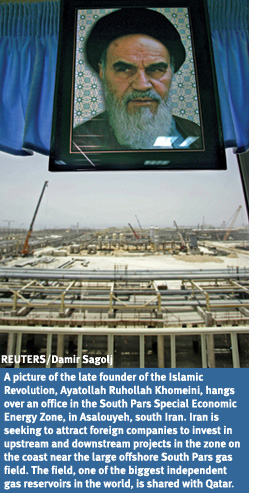Realising Iran’s gas wealth
$48 billion needed for projects; industry faces major challenges
IRAN needs to invest in excess of $48 billion into projects to tap its huge gas reserves of nearly 28 trillion cubic metres in the next 15 years and push economic growth which is largely reliant on crude oil exports.
 But Iran faces major challenges involving economic and political reforms, creation of jobs for the fast growing population and, not least, persistent tension over its nuclear programmes. But Iran faces major challenges involving economic and political reforms, creation of jobs for the fast growing population and, not least, persistent tension over its nuclear programmes.
At the Gas Arabia conference last month, Narsi Ghorban, Managing Director of the Iranian Narkangan Gas-to-Liquid (GTL) International Company, pinpointed the advantages and disadvantages of the new Iranian regime for the country’s future.
The new government
The new president and many government officials represent a generation whose defining experience was the Iran-Iraq war as opposed to the previous governments whose legitimacy came from the Islamic revolution.
War experience has taught them to be self-confident, defiant of big powers and distrustful of western promises and values.
The advantage of this generation is that they can more easily detach themselves from the mistakes of the past.
The key disadvantages are their lack of experience in political realities, international relations and Iran’s economy.
The emphasis of the new government is attending to the economic needs of the deprived sector of the society, stopping corruption and unnecessary government expenditure.
The energy issue, and particularly oil and gas, are the main focus of the new government.
Major challenges
Young people number around 40 million of the population. Nearly 1.5 million are university students and over 20 million in schools.
The young generation seeks better social and economic standards of life. Each year 800,000 jobs have to be created in the coming 15 years, a major task for any government.
Political reform is being driven by socio-economic realities such as demography, urbanisation, industrialisation, pluralism, influence of the Iranian diaspora and the impact of globalisation.
Unresolved internal political and socio-economic debate has delayed the formalisation of a moderate balance between Islamic values, democratic values and economic progress. The process has been slow and Iran may have taken a step backward in some occasions.
The young generation in general and the Iranian elite in particular are convinced that Iran deserves a much better international position given its human and natural resource potential and the country’s strategic position.
Continuing tension with the US has now escalated by IAEA reporting Iran to the Security Council over the nuclear issue. If this problem is not resolved diplomatically, it will have serious repercussions in Iran and the region.
Monetising gas wealth
Natural gas resources in Iran are estimated at around 28 trillion cubic metres, nearly 15 per cent of the world’s total proven gas reserves.
Domestic use: Replacing demand for petroleum products with gas and establishing gas based industries is a major priority of the new Government.
Gas injection: Enhanced oil recovery is another major priority to maintain oil production.
Natural gas exports: Pipeline priorities are based on strategic and political advantages in addition to economic benefits.
LNG: Not a priority of some policy makers.
Gas to petroleum products:
A priority as a local gas based industry helping to satisfy internal demand.
Gas injection in Iranian oil fields gives the best value for gas. Current gas injection into the fields is 35 billion cubic metres per year. If 150-200 cubic metres of gas is injected, it brings about one barrel of oil and if the price of oil is at $50 per barrel, the value of the gas is 25-33 cents per cubic metre. Most of the gas injected could be recovered latter.
Current gas consumption of about 100 billion cubic metres per year is equivalent to 1.7 million barrels of oil per day. If 200-250 cubic metres of gas replaces one barrel of petroleum products in future and the price of oil is at $50 per barrel, then the gas value would be 20-25 cents per cubic metre.
Gas export to Turkey will be 10 billion cubic metres per year by 2007 Export to Armenia and Georgia is around three billion cubic metres per year by 2008.
There is potential to export 20-25 billion cubic metres by 2020 to Europe via Turkey or other countries; 30 billion cubic meters a year to the Indian subcontinent by 2012; and export of LNG to India, Far East and Europe from 2010.
The economic advantages of gas to liquids for Iran would be the further monetization of gas resources; balancing the future demand for domestic petroleum products without building new oil refineries; superior environmental quality of the product; local input from engineering and construction companies
|



